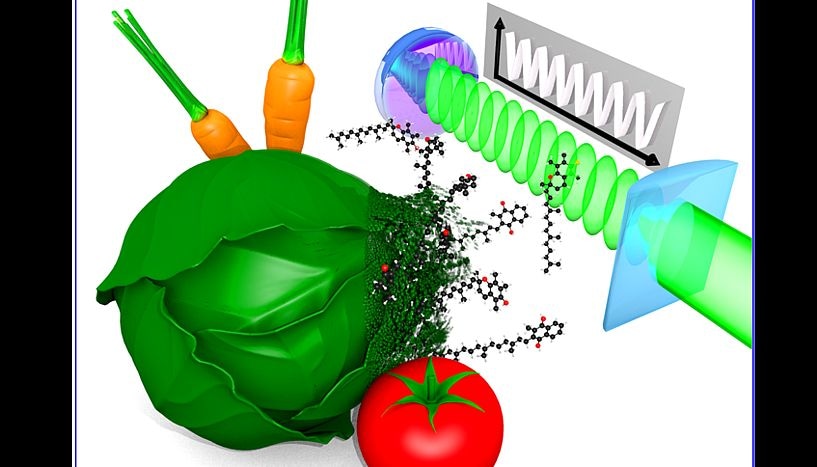Aug 23 2017
Quantum physics explains that unobserved particles may propagate through space like waves. This is considered to be philosophically captivating and of technological relevance.
A team of Researchers at the University of Vienna has demonstrated that incorporating experimental quantum interferometry with quantum chemistry enables deriving information about electronic and optical properties of biomolecules, here demonstrated with a set of vitamins. These results are featured in the journal "Angewandte Chemie International Edition".
 This artist’s view of the experiment illustrates that naturally occurring vitamins can be prepared in specific quantum states that facilitate the measurement of the molecular electronic properties (Copyright: Christian Knobloch, QNP Group, Faculty of Physics, University of Vienna).
This artist’s view of the experiment illustrates that naturally occurring vitamins can be prepared in specific quantum states that facilitate the measurement of the molecular electronic properties (Copyright: Christian Knobloch, QNP Group, Faculty of Physics, University of Vienna).
Quantum interference and metrology with molecules
The gas phase physical properties of vitamins are still less well studied even though they play a vital role in biology. The University of Vienna has now explored the potential of quantum-based methods in biomolecular studies. For that purpose, Lukas Mairhofer, Sandra Eibenberger and colleagues in the research group headed by Markus Arndt at the University of Vienna, developed molecular beams of (pro) vitamins A, E und K1, that is β-Carotin, α-Tocopherol und Phylloquinon.
These molecules are capable of flying in high vacuum via an arrangement of three nanogratings. The first grating forces each molecule through one of about a thousand slits, each of them only 110 nm wide. Based on Heisenberg’s uncertainty principle, this constriction of the molecular position requires an indeterminacy of the molecular direction of flight – the molecule is "delocalized" spatially. This leads to the preparation of the motional state of each molecule such that it becomes impossible, even in principle, to follow the path of the molecule through the experiment.
A green high-power laser beam helps in realizing the second grating and this beam is retro-reflected at a mirror within the vacuum. A standing light wave is produced, that is, a periodic array of regions of low and high light intensity. When they reach this second grating every single molecule is already delocalized such that their wave functions cover a number of dark and bright regions – despite the fact that these are more than a hundred times further separated than the size of one molecule. The molecules are more or less accelerated within the dark and bright zones. This controls the extended quantum wave front.
An interference pattern emerges since the molecules do not follow a well-defined path but instead follow a superposition of possible paths via the machine. This interference pattern refers to a periodic distribution of probabilities in order to detect a molecule at a given location. This is then followed by comparing the pattern with the third grating, which indeed is a copy of the first silicon nitride grating.
Quantum ruler for biomolecules
The ultra-fine structured interference pattern is employed as a quantum ruler in order to read out nanometric deflections of the molecular beam, which are difficult to measure by well-known methods. Information about the interaction of the biomolecules with external fields can be extracted as a result of the modulation and position of the interference pattern.
This involves the interaction with the diffracting laser beam and also with a controlled electric field that moves the molecular density pattern. The Researchers use this for determining optical and electronic properties of biologically relevant molecules, here the (pro)vitamins A, E und K1. For example, pro-vitamin A plays a vital role in photosynthesis.
We have a universal tool for improved measurements of biomolecular properties
Lukas Mairhofer, the main Author of this study
Comparison with molecular simulations
The results obtained from the experiments were compared with simulations. For that purpose, classical molecular dynamics simulations define the time evolution of the molecular structure and are integrated with density functional theory in order to evaluate the electronic properties. This results in a good agreement between theory and experiment. The incorporation of quantum chemistry and molecule interferometry serves as an example for the successful association at the interface between physical chemistry and quantum optics.